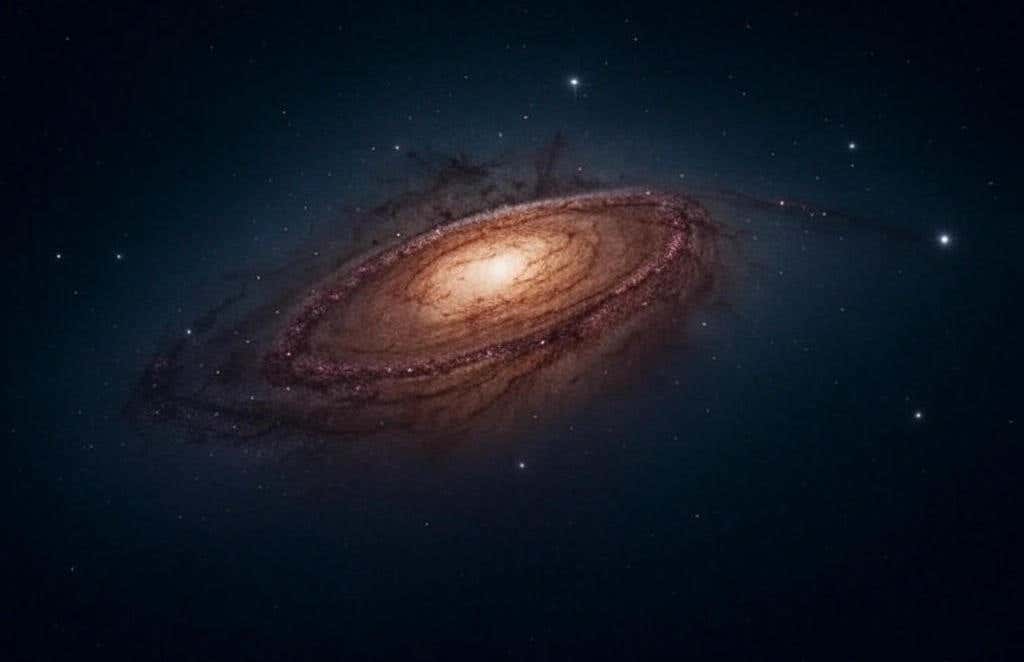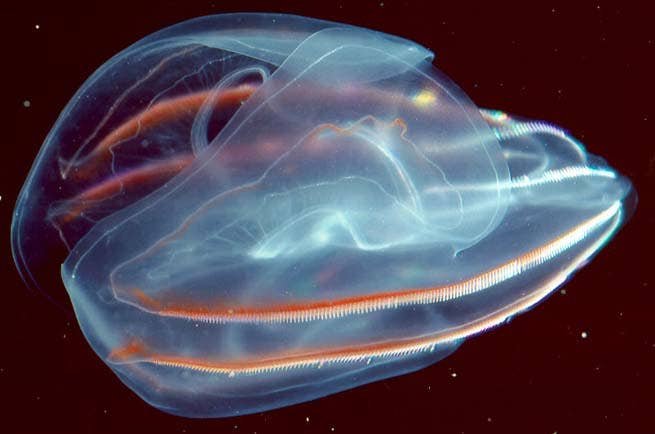Astronomers discover that galaxies die much earlier than expected
JWST confirms a massive galaxy that quenched star formation just 700 million years after the Big Bang, defying cosmic evolution models.

Illustration of the RUBIES-UDS-QG-z7 galaxy created with the Grok 3 AI. (CREDIT: CC BY-SA 4.0)
In a Universe that was only 700 million years old, long before Earth even formed, something unexpected happened. A massive galaxy stopped forming stars and went silent. This type of galaxy, called quiescent, typically needs billions of years to grow and then shut down star formation. But thanks to the powerful James Webb Space Telescope (JWST), astronomers have now confirmed that one such galaxy had already died young.
This ancient galaxy, called RUBIES-UDS-QG-z7, is now the most distant quiescent galaxy ever confirmed. It challenges current ideas about how quickly galaxies form and evolve in the early Universe. This discovery pushes the boundaries of what scientists thought was possible during cosmic dawn.
A galaxy that died too soon
Most galaxies in the early Universe were busy forming stars. They gathered gas from space, built up mass, and ignited in brilliant bursts of star birth. But RUBIES-UDS-QG-z7 did something different. It formed a large number of stars early on—equivalent to over 10 billion times the mass of our Sun—and then stopped completely. This quiet phase is known as quenching.
Data from JWST's Near Infrared Spectrograph (NIRSpec), gathered during the RUBIES survey (Red Unknowns: Bright Infrared Extragalactic Survey), confirmed the galaxy’s quiet state. It showed no signs of ongoing star formation. Instead, the spectrum revealed strong Balmer and Ca absorption features and a Lyman break—clear indicators of an older stellar population. What makes this even more surprising is the redshift of 7.29, placing the galaxy just a few hundred million years after the Big Bang.
The team used combined data from JWST’s NIRCam and MIRI instruments, covering light from 0.9 to 18 microns, to model the galaxy’s history. They found it had stopped forming stars around 50 to 100 million years before it was observed. That means it had likely completed its star-forming phase even before redshift 8.
Small but extremely dense
Despite its large stellar mass, RUBIES-UDS-QG-z7 is surprisingly compact. Its physical size measures only around 650 light-years across. That makes its stellar-mass surface density extremely high—among the densest observed in any galaxy. This level of compactness and mass density has only been seen before in massive elliptical galaxies at redshifts between 2 and 5.
Related Stories
Such dense, compact galaxies are believed to be the cores of giant elliptical galaxies found in today’s Universe. This discovery suggests that those cores could have already formed just a few hundred million years after the Big Bang. The structure of RUBIES-UDS-QG-z7 resembles what we see in the centers of old, massive ellipticals in the nearby Universe.
According to Anna de Graaff, postdoctoral researcher at the Max Planck Institute for Astronomy and lead investigator of the RUBIES program, “The discovery of RUBIES-UDS-QG-z7 provides the first strong evidence that the centers of some nearby massive ellipticals may have already been in place since the first few hundred million years of the Universe.”
Star death in a Universe full of life
The discovery adds to a growing list of high-redshift quiescent galaxies that are rewriting our understanding of early cosmic evolution. In the local Universe, nearly half of all galaxies are quiescent, often called “red and dead” due to the lack of young blue stars. But finding such galaxies in the early Universe is unexpected. Theoretical models predict that galaxies should take much longer to grow and shut off star formation.
Over the years, astronomers have been finding massive quiescent galaxies at earlier times, some at redshift 4 or even 5. These galaxies had already completed star formation within the first 1.2 billion years after the Big Bang. But RUBIES-UDS-QG-z7 pushes this timeline back even further.
Pascal Oesch, associate professor of astronomy at the University of Geneva and co-author of the study, explained the importance of these discoveries: “Finding the first examples of massive quiescent galaxies in the early Universe is critical as it sheds light on their possible formation mechanisms.”
RUBIES-UDS-QG-z7 may represent a phase in galaxy evolution that is still poorly understood. Scientists know that galaxies grow by pulling in gas, forming stars, and merging with others. But what makes some galaxies stop forming stars so early remains a mystery.
The models don’t add up
The discovery of RUBIES-UDS-QG-z7 brings a major challenge to current galaxy formation models. According to Andrea Weibel, PhD student at the University of Geneva and lead author of the paper, “The discovery of this galaxy implies that massive quiescent galaxies in the first billion years of the Universe are more than 100 times more abundant than predicted by any model to date.”
This means the models could be missing key ingredients. Theoretical simulations already account for the effects of star formation, black hole growth, and galactic winds. But clearly, these factors may not be strong enough or may be happening too late in the models to match what’s being observed.
Other studies have hinted that galaxy quenching can happen early. Compact, massive quiescent galaxies have been observed at redshifts between 2 and 5. About half of these systems had already shut down star formation by then, meaning they must have formed very early.
Some compact red sources, known as Little Red Dots, have been spotted at redshifts around 7 to 8. These could be candidates for early quiescent galaxies. However, their exact nature is still unclear because their stellar masses are difficult to confirm. Active galactic nuclei may be affecting the light from these objects, making it hard to determine if they are truly massive or just appear that way.
Despite these uncertainties, the confirmation of RUBIES-UDS-QG-z7 marks a clear example of a massive galaxy that quenched extremely early. Its discovery confirms that such objects do exist and that the early Universe was more diverse than once believed.
JWST opens a new window into the past
Before JWST, spotting galaxies like RUBIES-UDS-QG-z7 was almost impossible. Telescopes like Hubble and ground-based instruments could not see deep enough into the near-infrared to detect features like the Balmer break at such high redshifts. While Spitzer offered some infrared capability, it lacked the resolution and sensitivity needed for firm conclusions.
JWST changes all that. Its ability to collect detailed infrared spectra has already revealed galaxies forming stars as early as 300 million years after the Big Bang. And now, it’s showing that some galaxies stopped forming stars not long after that.
The RUBIES survey is one of the largest European-led programs using JWST’s NIRSpec instrument. It has already gathered thousands of spectra and is helping astronomers uncover the hidden population of ancient galaxies. RUBIES-UDS-QG-z7 stands out as the most distant quiescent galaxy yet confirmed, but more are likely waiting to be found.
While the discovery raises new questions, it also offers a rare chance to study how galaxies lived—and died—in the early Universe. As astronomers continue to explore with JWST, the cosmic story of galaxy evolution will keep growing richer and more surprising.
Research findings are available online in the The Astrophysical Journal.
Note: The article above provided above by The Brighter Side of News.
Like these kind of feel good stories? Get The Brighter Side of News' newsletter.
Joshua Shavit
Science & Technology Writer | AI and Robotics Reporter
Joshua Shavit is a Los Angeles-based science and technology writer with a passion for exploring the breakthroughs shaping the future. As a contributor to The Brighter Side of News, he focuses on positive and transformative advancements in AI, technology, physics, engineering, robotics and space science. Joshua is currently working towards a Bachelor of Science in Business Administration at the University of California, Berkeley. He combines his academic background with a talent for storytelling, making complex scientific discoveries engaging and accessible. His work highlights the innovators behind the ideas, bringing readers closer to the people driving progress.



